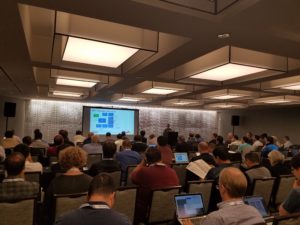Reviews are in for the 20th Storage Developer Conference (SDC) and they are thumbs up! The 2017 SDC was the largest ever- expanding to four full days with seven keynotes, five SNIA Tutorials, and 92 sessions. The SNIA Technical Council, who oversees conference content, compiled a rich agenda of 18 topic categories  focused on Read More
focused on Read More
Category: Fabric
Does Your World Include Storage? Don’t Miss SDC!
Whether storage is already a main focus of your career or may be advancing toward you, you’ll definitely want to attend the flagship event for storage developers – and those involved in storage operations, decision making, and usage – SNIA’s 19th annual Storage Developer Conference (SDC), September 11-14, 2017 at the Hyatt Regency Santa Clara, California. Read More
Clearing Up Confusion on Common Storage Networking Terms
Do you ever feel a bit confused about common storage networking terms? You’re not alone. At our recent SNIA Ethernet Storage Forum webcast “Everything You Wanted To Know About Storage But Were Too Proud To Ask – Part Mauve,” we had experts from Cisco, Mellanox and NetApp explain the differences between:
- Channel vs. Busses
- Control Plane vs. Data Plane
- Fabric vs. Network
If you missed the live webcast, you can watch it on-demand. As promised, we’re also providing answers to the questions we got during the webcast. Between these questions and the presentation itself, we hope it will help you decode these common, but sometimes confusing terms.
And remember, the “Everything You Wanted To Know About Storage But Were Too Proud To Ask” is a webcast series with a “colorfully-named pod” for each topic we tackle. You can register now for our next webcast: Part Teal, The Buffering Pod, on Feb. 14th.
Q. Why do we have Fibre and Fiber
A. Fiber Optics is the term used for the optical technology used by Fibre Channel Fabrics. While a common story is that the “Fibre” spelling came about to accommodate the French (FC is after all, an international standard), in actuality, it was a marketing idea to create a more unique name, and in fact, it was decided to use the British spelling – “Fibre”.
Q. Will OpenStack change all the rules of the game?
A. Yes. OpenStack is all about centralizing the control plane of many different aspects of infrastructure.
Q. The difference between control and data plane matters only when we discuss software defined storage and software defined networking, not in traditional switching and storage.
A. It matters regardless. You need to understand how much each individual control plane can handle and how many control planes you have from a overall management perspective. In the case were you have too many control planes SDN and SDS can be a benefit to you.
Q. As I’ve heard that networks use stateless protocols, would FC do the same?
A. Fibre Channel has several different Classes, which can be either stateful or stateless. Most applications of Fibre Channel are Class 3, as it is the preferred class for SCSI traffic, A connection between Fibre Channel endpoints is always stateful (as it involves a login process to the Fibre Channel fabric). The transport protocol is augmented by Fibre Channel exchanges, which are managed on a per-hop basis. Retransmissions are handled by devices when exchanges are incomplete or lost, meaning that each exchange is a stateful transmission, but the protocol itself is considered stateless in modern SCSI-transport Fibre Channel.
iSCSI, as a connection-oriented protocol, creates a nexus between an initiator and a target, and is considered stateful. In addition, SMB, NFSv4, ftp, and TCP are stateful protocols, while NFSv2, NFSv3, http, and IP are stateless protocols.
Q. Where do CIFS/SMB come into the picture?
A. CIFFS/SMB is part of a network stack. We need to have a separate talk about network stacks and their layers. In this presentation, we were talking primarily about the physical layer of the networks and fabrics. To overly simplify network stacks, there are multiple layers of protocols that run on top of the physical layer. In the case of FC, those protocols include the control plane protocols (such as FC-SW), and the data plane protocols. In FC, the most common data plane protocol is FCP (used by SCSI, FICON, and FC-NVMe). In the case of Ethernet, those protocols also include the control plan (such as TCP/IP), and data plane protocols. In Ethernet, there are many commonly used data plane protocols for storage (such as iSCSI, NFS, and CIFFS/SMB)